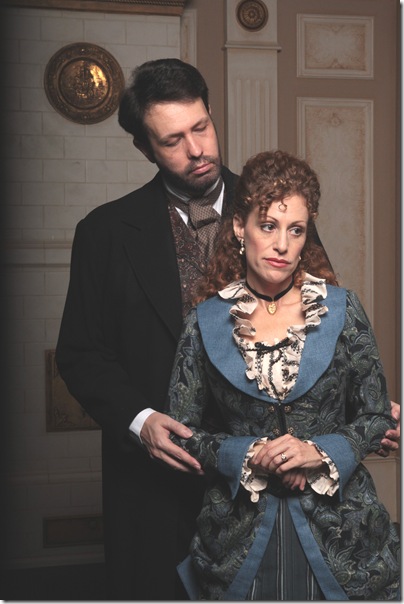Ah, to have been in Copenhagen’s Royal Theatre that night in late December 1879, when Henrik Ibsen elicited shock and outrage with his new play, A Doll’s House, and particularly the final door-slamming, convention-flaunting exit of its heroine, Nora Helmer.
Watching what she endures through 21st century eyes, however, the only conceivable response is a hearty, “You go, girl,” and puzzlement that she managed to endure eight years of marriage to her parental clod of a husband, Torvald.
If Ibsen was ahead of the curve in social attitudes when he wrote this play, surely he is way behind it today. The same, I’m afraid, goes for his sense of drama, or rather melodrama.
If you will recall, for most of A Doll’s House, it is not being under Torvald’s thumb that worries Nora, but the creaky plot device of her forging her father’s signature on a loan application, leading to her being blackmailed by a lowly bank official who has discovered her transgression.
Palm Beach Dramaworks, now in its 10th season, has staked out the laudable mission of producing once-classic, but now neglected plays for their intrinsic value. Fair enough, but sometimes there is a very good reason why a classic has fallen into neglect. A Doll’s House may have outlived its purpose — to illustrate one woman’s no-longer-shocking march towards liberation.
Instead, the reason to revive this play is if you have a luminous actress for the role of Nora, who occupies center stage for most of the evening. In Dramaworks’ case, the answer is “yes” and “no.”
Margery Lowe is frequently cast at the compact Banyan Boulevard playhouse, sometimes to very good results (Seascape, Who’s Afraid of Virginia Woolf?), sometimes miscast (Agnes of God) and occasionally stuck in an unplayable role (At Home at the Zoo). As Nora in A Doll’s House, she comes on impressively strong in the final act, turning on Torvald for treating her like a plaything and trying to suffocate her spirit.
But for the sake of contrast, Lowe miscalculates, making the pre-realization Nora into a child-woman, leaning heavily on the girlish giggles, sing-song cadences and unsubtle wind-up doll movements. One would have to be terminally symbolism-challenged not to get the point within minutes of the play’s start. Either Torvald is very good at turning his wife into a doll or she has gone out of her way to indulge his taste in subservient women.
Whichever it is, Ibsen does not help matters by having Nora’s “Click!” moment — as Gloria Steinem would put it — during intermission. It is not that Nora’s character has a huge contrasting arc, but rather it is an on-off switch. Although Dramaworks chose to produce a fairly new adaptation of the play by Frank McGuiness (Someone Who’ll Watch Over Me), his script does nothing to inject a more modern viewpoint or dramaturgy.
The play succeeds or fails on the merits of its Nora, but Michael St. Pierre (Torvald) is aptly stolid as the very model of a major male chauvinist. Gregg Weiner comes off as constricted by the role of extortionist Krogstad, though he manages to humanize the character in a second act scene with Nora’s timid childhood chum, Mrs. Linde (Nanique Gheridian).
If, as is likely, you are way out ahead of the story line, you can always spend your time appreciating scenic designer Michael Amico’s austere living room set or Brian O’Keefe’s meticulous costumes, especially Nora’s wardrobe.
Palm Beach Dramaworks has spent the decade cultivating a theater savvy audience which, in all likelihood, is familiar with A Doll’s House. But William Hayes’s direction seems oblivious to that, expecting instead audience gasps at the play’s conclusion. Unfortunately for him, it is no longer 1879.
A DOLL’S HOUSE, Palm Beach Dramaworks, 322 Banyan Blvd., West Palm Beach. Continuing through Nov. 29. Tickets: $40-$42. Call: (561) 514-4042.
